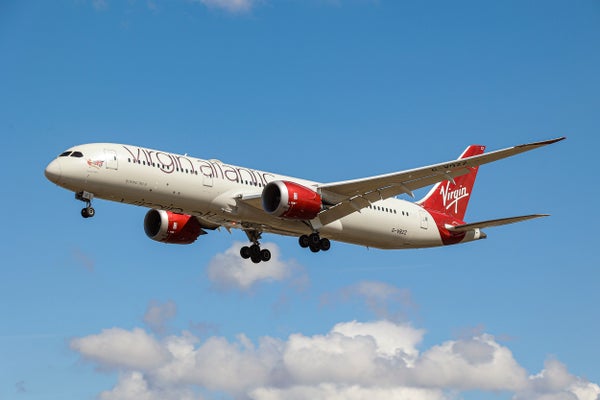November 29, 2023
3 min read
Virgin Atlantic flew the first large commercial jet to traverse the Atlantic with 100 percent sustainable aviation fuel
By Brian Dabbs & E&E News

A Virgin Atlantic Airways Boeing 787 Dreamliner as seen on final approach to London Heathrow Airport.
CLIMATEWIRE | A Boeing 787 departed London Heathrow on Tuesday with historic cargo: 60 tons of waste fats and low-carbon kerosene to power a Virgin Atlantic flight across the Atlantic Ocean.
Roughly seven and a half hours later, the aircraft touched down at John F. Kennedy International Airport in New York, becoming the first large commercial airliner to traverse the Atlantic with 100 percent sustainable aviation fuel (SAF), a family of biofuel technologies billed by the Biden administration and industry as the chief near-term solution to dramatically decarbonize the global aviation sector.
Joey Cathcart, a senior associate at the environmental group RMI who was on board, said “SAF is going to be a significant part of the long-term decarbonization for aviation, especially for long-haul routes.”
“From a passenger experience standpoint, the flight is as if you’re on any other flight, but your carbon impact is 70 percent reduced,” he said in an interview after landing in New York.
Virgin Atlantic hailed the flight as a “culmination of a year of radical collaboration” featuring RMI, Boeing, Rolls-Royce and other organizations. Rolls-Royce supplied the Trent 1000 engine, and the project received funding from the United Kingdom’s Department for Transport.
The announcement came a week after business jet operator Gulfstream Aerospace Corp. flew what it called the first transatlantic flight fueled by SAF. That aircraft model can hold 19 passengers, a fraction of the roughly 248 passengers that can fit on a commercial 787.
Globally, SAF has been slow to gain traction because of higher costs and limited supplies. Last year, U.S. production totaled 15.8 million gallons — less than 0.1 percent of total fuel consumed by U.S. airlines and far short of the Federal Aviation Administration’s previous goal to use 1 billion gallons of sustainable aviation fuel annually by 2018. The Biden administration is now aiming for the U.S. to produce 3 billion gallons of SAF annually by 2030.
U.S. companies are eyeing an Inflation Reduction Act program that could award a tax credit of between $1.25 and $1.75 per gallon of SAF. Environmentalists and farmers have sparred over whether corn-based ethanol should qualify for the credit, sparking a debate about whether the government will actually be supporting “clean” fuel.
Tax experts say the final rules for the credit are likely by the end of the year. A Treasury Department spokesperson declined to comment on timing.
Aviation accounts for approximately 2 percent of global emissions, according to the International Energy Agency. The main global airline association, the International Air Transport Association, is targeting net-zero emissions in the sector by 2050. Meanwhile, International Civil Aviation Organization member states agreed last week to cut aviation sector carbon dioxide emissions five percent by 2030.
While electric vehicle market shares grow steadily and the U.S. power sector slashes emissions, the aviation sector is considered a much more difficult decarbonization challenge, along with the cement and steel industries. Lithium-ion and other batteries aren’t energy dense enough and are too heavy to power a jet. The hydrogen aviation sector also is in its infancy.
To cut aviation emissions, several companies have announced SAF targets. U.S. biofuels producer Gevo is aiming to produce 1 billion gallons annually of biofuel by 2030. Finland-based Neste is set to produce 500 million gallons of waste-based SAF annually by the beginning of 2024. One type of waste SAF called hydroprocessed esters and fatty acids (HEFA) was used on the Virgin transatlantic flight with a blend of “synthetic aromatic kerosene.” Neste, the world’s largest SAF producer, is supplying HEFA to power jets at the Los Angeles and San Francisco international airports.
Shai Weiss, CEO Virgin Atlantic, called for more SAF production.
“There’s simply not enough SAF and it’s clear that in order to reach production at scale, we need to see significantly more investment,” he said in a statement issued before the flight had landed. “This will only happen when regulatory certainty and price support mechanisms, backed by Government, are in place.”
SAF has support in both political parties, although it has faced political attacks. Earlier this year, Sen. Ted Cruz (R-Texas) said SAF “risks becoming the new Solyndra,” a reference to a solar panel company that in 2011 defaulted on a $535 million loan from the Department of Energy.
The Virgin flight was only offered to “observers” linked to the project, rather than standard commercial travelers, according to Cathcart.
Air BP, the aviation division of the U.K. oil giant BP, supplied the HEFA for the Virgin flight, while Virent, a subsidiary of Marathon Petroleum, supplied the kerosene.
This story also appears in Energywire.
Reprinted from E&E News with permission from POLITICO, LLC. Copyright 2023. E&E News provides essential news for energy and environment professionals.
>>> Read full article>>>
Copyright for syndicated content belongs to the linked Source : Scientific American – https://www.scientificamerican.com/article/commercial-airliner-is-first-to-cross-atlantic-with-biofuel-power/